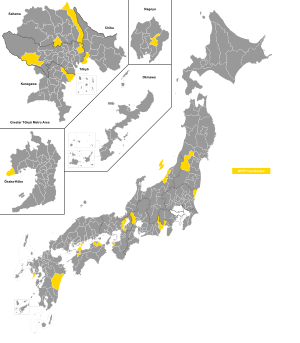
Politics of Japan are conducted in a framework of a dominant-party bicameral parliamentary constitutional monarchy, in which the Emperor is the head of state and the Prime Minister is the head of government and the head of the Cabinet, which directs the executive branch.

The Liberal Democratic Party, frequently abbreviated to LDP or Jimintō (自民党), is a major conservative and Japanese nationalist political party in Japan.
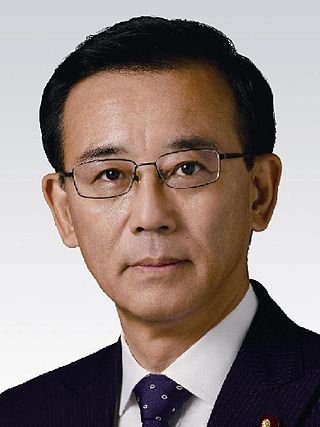
Sadakazu Tanigaki is a Japanese politician who served as a member of the House of Representatives from 1983 to 2016, as Minister of Finance from 2003 to 2006, as President of the Liberal Democratic Party and Leader of the Opposition from 2009 to 2012, as Minister of Justice from 2012 to 2014, and as LDP Secretary-General from 2014 to 2016. He was only the second LDP leader who was not simultaneously Prime Minister of Japan. He retired from politics following a spinal cord injury in 2016 that saw him using a wheelchair.
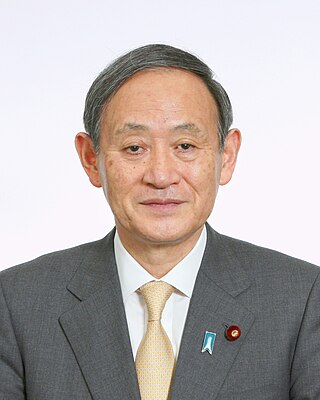
Yoshihide Suga is a Japanese politician who served as Prime Minister of Japan and President of the Liberal Democratic Party (LDP) from 2020 to 2021. He had served as Chief Cabinet Secretary during the second administration of Prime Minister Shinzo Abe from 2012 to 2020. During Abe's first administration, Suga served as Minister for Internal Affairs and Communications from 2006 to 2007.

Sanae Takaichi is a Japanese politician who has served as the Minister of State for Economic Security since August 2022. A member of the Liberal Democratic Party, she has served in the House of Representatives since 2005, and had also served in several ministerial posts under Prime Minister Shinzo Abe. In 2021, she was a candidate in the Liberal Democratic Party leadership election, but was ultimately eliminated in a run-off, placing third.

Kōichi Hagiuda is a Japanese politician who served as the Chairman of the Policy Research Council of the Liberal Democratic Party from August 2022 to December 2023. He previously served as Minister of Economy, Trade and Industry, and was Deputy Chief Cabinet Secretary from 2015 to 2016 and Minister of Education, Culture, Sports, Science and Technology from 2019 to 2021.
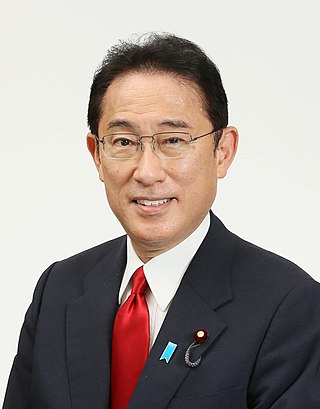
Fumio Kishida is a Japanese politician who has served as Prime Minister of Japan and President of the Liberal Democratic Party (LDP) since 2021. A member of the House of Representatives, he previously served as Minister for Foreign Affairs from 2012 to 2017 and as acting Minister of Defense in 2017. From 2017 to 2020, he also chaired the LDP Policy Research Council.

Toshimitsu Motegi is a Japanese politician who currently serves as the Secretary-General of the Liberal Democratic Party. He has previously served as Minister for Foreign Affairs from 2019 to 2021, and as Minister of Economy, Trade and Industry from 2012 to 2014. He is serving in the House of Representatives as a member of the Liberal Democratic Party. He leads the Heisei Kenkyūkai faction within the LDP.
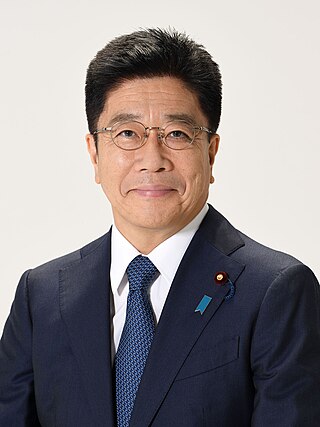
Katsunobu Kato is a Japanese politician who previously serves as the Minister of Health, Labour and Welfare three times from 2017 to 2018, from 2019 to 2020, and from 2022 to 2023. He also served as Chief Cabinet Secretary from 2020 to 2021. Belonging to the Liberal Democratic Party, he has been a member of the House of Representatives since 2003.

Nobuo Kishi is a Japanese politician. He sat in the House of Representatives from 2012 to 2023 representing Yamaguchi’s 2nd District as a member of the Liberal Democratic Party. From September 2020 to August 2022 he served as the Minister of Defense. He is the younger brother of former Japanese prime minister Shinzo Abe.

General elections were held in Japan on 16 December 2012. Voters gave the Liberal Democratic Party a landslide victory, ejecting the Democratic Party from power after three years. It was the fourth worst defeat suffered by a ruling party in Japanese history.

General elections were held in Japan on 22 October 2017. Voting took place in all Representatives constituencies of Japan – 289 single-member districts and eleven proportional blocks – in order to appoint all 465 members of the House of Representatives, the lower house of the then 707-member bicameral National Diet of Japan. Incumbent Prime Minister Shinzō Abe's governing coalition of the Liberal Democratic Party (LDP) and the Komeito party retained their seats in signs of what was perceived as weak opposition. The PM won his fourth term in office and held on to the two-thirds supermajority in order to implement policies on revising the war-renouncing Article 9 of the Japanese Constitution.

Yuichiro Tamaki is a Japanese politician and the leader of the Democratic Party for the People (DPFP). He is a member of the House of Representatives, and a former leader of Kibō no Tō. Before joining Kibō, Tamaki was a member of the Democratic Party.
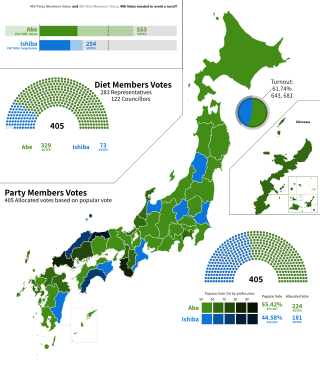
A leadership election was held on 20 September 2018 to elect the next president of the Liberal Democratic Party of Japan for a new 3-year term. Incumbent president Shinzo Abe was running for re-election after a rule change in 2017 that allowed him to run for a third term.

Reiwa Shinsengumi is a progressive and left-wing populist political party in Japan founded by actor-turned-politician Taro Yamamoto in April 2019. The party was formed by left-wing members of the Liberal Party who opposed its merger with the Democratic Party for the People. The party won more than 4% of the vote after contesting the House of Councilors election in July 2019, gaining two seats only about three and a half months after the formation of the party.

The 2020 Liberal Democratic Party of Japan leadership election was triggered by Shinzo Abe's announcement on 28 August 2020 that he would resign as President of the Liberal Democratic Party and Prime Minister of Japan, citing a relapse of his colitis. Voting took place on 14 September 2020 to elect the next president of the Liberal Democratic Party of Japan, three days before the National Diet was scheduled to hold a session to elect the new Prime Minister. Initially scheduled to be held in September 2021, incumbent LDP president and the longest-serving Prime Minister of Japan, Shinzo Abe, suddenly resigned on 28 August 2020, citing recent health concerns, prompting an election to select the President to serve the rest of Abe's term.

Prefectural elections for the Tokyo Metropolitan Assembly were held on 4 July 2021. The 127 members were elected in forty-two electoral districts, seven returning single members elected by first-past-the-post, and thirty-five returning multiple members under single non-transferable vote. Two districts had their magnitude adjusted in this election to match population changes.

The 2021 Liberal Democratic Party leadership election was held on 29 September 2021 to elect the next President of the Liberal Democratic Party of Japan and Prime Minister of Japan. Kishida was elected to lead the party, and assumed the premiership on 4 October. He led the party into the 2021 Japanese general election.

House of Councillors elections were held in Japan on 10 July 2022 to elect 125 of the 248 members of the upper house of the National Diet, for a term of six years. The elections occurred after the assassination of Shinzo Abe, former Prime Minister of Japan on 8 July 2022. The elected candidate with the fewest votes in the Kanagawa prefectural district will serve for three years, as the district combined its regular and byelections.
The 2023 Japanese unified local elections were held across the country on 9 and 23 April 2023. In total 15,047 candidates were elected in 1008 races with a high of 1,685 in Hokkaido and a low of 1 in Okinawa.










